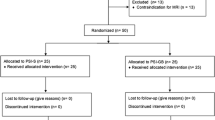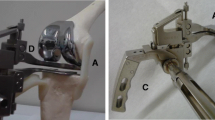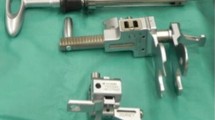Abstract
It is unknown how intra-operative soft-tissue balance affects post-operative knee kinematics during different functional tasks. In order to clarify this relationship, the intra-operative varus–valgus balance and post-operative knee kinematics were compared for 17 patients who underwent total knee arthroplasty using a modified gap technique. The intra-operative balance was recorded with a tensor device, and in vivo knee kinematics of lunging, kneeling and non–weight-bearing knee extension were analyzed with 3D-to-2D model registration techniques. Femoral condylar separation from the tibial articular surface also was investigated. The post-operative varus–valgus angle in 90° kneeling had a strong relationship with the intra-operative varus–valgus angle, while there was a weak relationship for the non–weight-bearing motion at 0° and 90° flexion. Articular surface separation was an uncommon observation, seen in 2.2% of images during non–weight-bearing motion and in none of the lunging or kneeling images. The modified gap technique appears effective providing stable knee arthroplasty kinematics during in vivo activities with minimal articular separation in non–weight-bearing motion.



Similar content being viewed by others
References
Banks SA, Hodge WA (1996) Accurate measurement of three-dimensional knee replacement kinematics using single-plane fluoroscopy. IEEE Trans Biomed Eng 43:638–649
Banks SA, Harman MK, Hodge WA (2002) Mechanism of anterior impingement damage in total knee arthroplasty. J Bone Joint Surg Am 84A(2):37–42
Clayton ML, Thompson TR, Mack RP (1986) Correction of alignment deformities during total knee arthroplasties: staged soft-tissue releases. Clin Orthop Relat Res 202:117–124
Dennis DA, Komistek RD, Walker SA, Cheal EJ, Stiehl JB (2001) Femoral condylar lift-off in vivo in total knee arthroplasty. J Bone Joint Surg Br 83B:33–39
Fregly BJ, Banks SA, D’Lima DD, Colwell CW Jr (2008) Sensitivity of knee replacement contact calculations to kinematic measurement errors. J Orthop Res 26:1173–1179
Gamada K, Jayasekera N, Kashif F, Fennema P, Schnotzer H, Banks SA (2008) Does ligament balancing technique affect kinematics in rotating platform knee arthroplasties?: a prospective randomized study. Knee Surg Sports Traumatol Arthrosc 16:160–166
Insall JN, Easley ME (2001) Surgical techniques and instrumentation in total knee arthroplasty. In: Insall JN, Scott WN (eds) Surgery of the knee, vol 2, 3rd edn. Churcill Livingstone, New York, pp 1553–1620
Kanekasu K, Banks SA, Honjo S, Nakata O, Kato H (2004) Fluoroscopic analysis of knee arthroplasty kinematics during deep flexion kneeling. J Arthroplasty 19:998–1003
Lee SY, Matsui N, Kurosaka M, Komistek RD, Mahfouz M, Dennis DA, Yoshiya S (2005) A posterior-stabilized total knee arthroplasty shows condylar lift-off during deep knee bends. Clin Orthop Relat Res 435:181–184
Lombardi AVJ (2003) Soft tissue balancing of the knee-flexion. In: Callaghan JJ, Rosenberg AG, Rubash HE, Simonian PT, Wickiewicz TL (eds) The adult knee, vol 2. Lippincott Williams, Wilkins, pp 1223–1232
Matsueda M, Gengerke TR, Murphy M, Lew WD, Gustilo RB (1999) Soft tissue release in total knee arthroplasty. Cadaver study using knees without deformities. Clin Orthop Relat Res 366:264–273
Scuderi GR, Komistek RD, Dennis DA, Insall JN (2003) The impact of femoral component rotational alignment on condylar lift-off. Clin Orthop Relat Res 410:148–154
Stiehl JB, Dennis DA, Komistek RD, Crane HS (1999) In vivo determination of condylar lift-off and screw-home in a mobile-bearing total knee arthroplasty. J Arthroplasty 14:293–299
Wasielewski RC, Galat DD, Komistek RD (2004) An intraoperative pressure-measuring device used in total knee arthroplasties and its kinematics correlations. Clin Orthop Relat Res 427:171–178
Whiteside LA, Saeki K, Mihalko WM (2000) Functional medical ligament balancing in total knee arthroplasty. Clin Orthop Relat Res 380:45–57
Zhao D, Banks SA, D’Lima DD, Colwell CW Jr, Fregly BJ (2007) In vivo medial and lateral tibial loads during dynamic and high flexion activities. J Orthop Res 25:593–602
Author information
Authors and Affiliations
Corresponding author
Rights and permissions
About this article
Cite this article
Moro-oka, Ta., Shiraishi, H., Iwamoto, Y. et al. Modified gap-balancing technique in total knee arthroplasty: evaluation of the post-operative coronal laxity. Knee Surg Sports Traumatol Arthrosc 18, 375–380 (2010). https://doi.org/10.1007/s00167-009-0977-8
Received:
Accepted:
Published:
Issue Date:
DOI: https://doi.org/10.1007/s00167-009-0977-8




